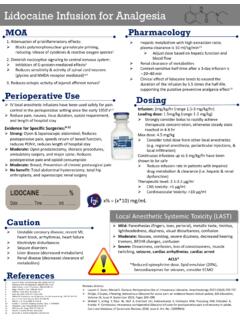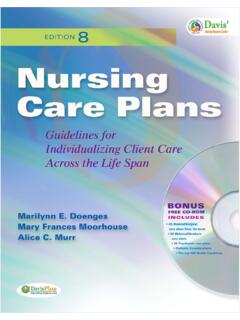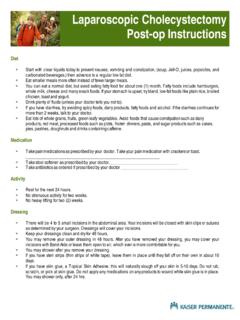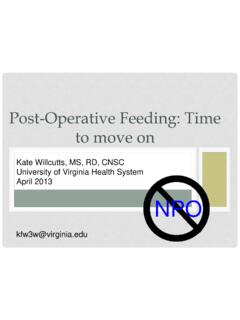Transcription of Intravenous Nicardipine - EMCrit
1 Drugs 2006; 66 (13): 1755-1782 ADIS DRUG EVALUATION0012-6667/06/0013-1755/$ 2006 Adis Data Information BV. All rights NicardipineIts Use in the Short-Term Treatment of Hypertension andVarious Other IndicationsMonique P. Curran, Dean M. Robinson and Gillian M. KeatingAdis International Limited, Auckland, New ZealandVarious sections of the manuscript reviewed Abernethy, National Institute on Aging, National Institutes of Health, Baltimore, Maryland, USA; , Department of Anesthesia, University of Pennsylvania, Philadelphia, Pennsylvania, USA; , Department of Neurology and Neurosciences, University of Medicine and Dentistry of NewJersey, Newark, New Jersey, USA; Goldberg, Cooper University Hospital, Camden, New Jersey, USA;M.
2 Mitsnefes, Division of Nephrology and Hypertension, Cincinnati Children s Hospital Medical Center,Cincinnati, Ohio, USA; Pepine, University of Florida College of Medicine, Gainesville, Florida, USA; , Eugene Applebaum College of Pharmacy and Health Sciences Wayne State, Detroit, Michigan, USA; Suarez, University Hospitals of Cleveland, Cleveland, Ohio, USA; J. Varon, The University of TexasHealth Science Center, Houston, Texas, SelectionSources: Medical literature published in any language since 1980 on Nicardipine , identified using MEDLINE and EMBASE, supplementedby AdisBase (a proprietary database of Adis International). Additional references were identified from the reference lists of publishedarticles.
3 Bibliographical information, including contributory unpublished data, was also requested from the company developing the strategy: MEDLINE and EMBASE search terms were Nicardipine and Intravenous . AdisBase search terms were Nicardipine and( Intravenous or IV in title). Searches were last updated June 24 : Studies in patients who received Intravenous Nicardipine . Inclusion of studies was based mainly on the methods section of thetrials. When available, large, well controlled trials with appropriate statistical methodology were preferred. Relevant pharmacodynamic andpharmacokinetic data are also terms: Intravenous Nicardipine , hypertension, pharmacodynamics, pharmacokinetics, therapeutic use.
4 Pharmacodynamic Pharmacokinetic Absorption and Metabolism and Special Patient Drug Therapeutic Severe Perioperative Postoperative Intra-operative Controlled Intra-operative Prior to Laryngoscopy and Tracheal Prior to Emergence from Anaesthesia and et Neurovascular Aneurysmal Subarachnoid Acute Intracerebral Acute Ischaemic Neurovascular Severe Head Aortic Special Patient Paediatric Elderly Acute Heart Premature Raynaud s Electroconvulsive Dosage and Place of Intravenous Nicardipine in the Short-Term Management of Hypertension and VariousOther is a water soluble calcium channel antagonist, with predominantlyAbstractvasodilatory (IV) Nicardipine (Cardene IV), which demonstrates a relativelyrapid onset/offset of action, is used in situations requiring the rapid control ofblood pressure (BP).
5 IV Nicardipine was as effective as IV nitroprusside in theshort-term reduction of BP in patients with severe or postoperative potential role for IV Nicardipine in the intraoperative acute control of BP inpatients undergoing various surgical procedures (including cardiovascular,neurovascular and abdominal surgery), and in the deliberate induction of reducedBP in surgical procedures in which haemostasis may be difficult ( surgeryinvolving the hip or spine) was demonstrated in preliminary studies. Preliminarystudies also indicated the ability of a bolus dose of IV Nicardipine to attenuate thehypertensive response, but not the increase in tachycardia, after laryngoscopy andtracheal intubation in anaesthetised patients.
6 In large, well designed studies, IVnicardipine prevented cerebral vasospasm in patients with recent aneurysmalsubarachnoid haemorrhage; however, overall clinical outcomes at 3 months weresimilar to those in patients who received standard management. Small preliminarystudies have investigated the use of IV Nicardipine in a variety of other settings,including acute intracerebral haemorrhage, acute ischaemic stroke, pre-eclampsia,acute aortic dissection, premature labour and electroconvulsive conclusion, the efficacy of IV Nicardipine in the short-term treatment ofhypertension in settings for which oral therapy is not feasible or not desirable iswell established.
7 The ability to titrate IV Nicardipine to the tolerance levels ofindividual patients makes this agent an attractive option, especially in critically illpatients or those undergoing surgery. Potential exists for further investigation ofthe use of this agent in clinical settings where a vasodilatory agent with minimalinotropic effects is appropriate. 2006 Adis Data Information BV. All rights 2006; 66 (13) Intravenous Nicardipine : A Review1757 Nicardipine is a dihydropyridine calcium channel antagonist, with greater selec-Pharmacologicaltivity for L-type calcium channels in vascular smooth muscle than cardiacPropertiesmyocytes. Nicardipine demonstrates strong coronary and cerebral vasodilatoryactivity.
8 It induces relatively rapid changes in BP, with minimal inotropic cardiaceffects and no significant venodilatory action. The vasodilatory effects ofnicardipine appear to be greater in patients with hypertension than in healthynormotensive volunteers. Nicardipine is highly patients with coronary artery disease, with and without impaired leftventricular function, IV Nicardipine (with or without -adrenoceptor antagonists)increased cardiac output, stroke volume and left ventricular ejection fraction, buthad no significant effect on left ventricular end-diastolic pharmacokinetics of a continuous infusion of IV Nicardipine or a bolusdose of IV Nicardipine were linear in patients with mild to moderate dose-related increases in plasma concentrations of Nicardipine occurredduring the first 2 hours after initiation of a 48-hour continuous infusion of IVnicardipine.
9 Thereafter, the Nicardipine concentration rose more slowly and took24 48 hours to reach steady state. Nicardipine plasma concentrations declinedtriexponentially after an IV infusion, with an initial rapid distribution half-life(t1/2 minutes), followed by an intermediate elimination half-life (t1/2 ) and a slow terminal elimination half-life (t1/2 hours). Nicardipine ishighly bound to plasma proteins (>95%) over a wide range of metabolism occurs mainly in the liver, primarily by cytochrome P450(CYP)2C8, CYP2D6 and CYP3A4 enzyme isoforms. Excretion occurred inapproximately equal proportions in the urine (49%) and faeces (43%), with nounchanged drug continuous infusion of IV Nicardipine was as effective as a continuous infusionTherapeutic Efficacyof IV nitroprusside in the reduction of BP in patients with severe hypertension(systolic BP >200mm Hg, diastolic BP >120mm Hg), with a similar proportion ofpatients ( 93%) achieving the therapeutic BP target within a similar timeframe(approximately 60 minutes).
10 IV Nicardipine was as effective as IV nitroprusside in effectively controllingpostoperative hypertension in patients who had undergone either cardiac ornoncardiac surgery. However, with IV Nicardipine , compared with IV nitroprus-side, the time required to reach a therapeutic response was significantly less. Datafrom a number of preliminary studies support the intraoperative efficacy of IVnicardipine in the acute control of BP in patients undergoing various surgicalprocedures (including cardiac surgery, intracranial aneurysm clipping and abdom-inal surgery). IV Nicardipine was effective in inducing deliberate hypotension(mean arterial pressure [MAP] 55 60mm Hg), and consequently limiting bloodloss during specified surgical procedures in which surgical haemostasis may bedifficult to achieve ( surgery involving the hip or spine); once the infusion hadceased, the time to return to baseline MAP was longer with IV Nicardipine than IVnitroprusside.




